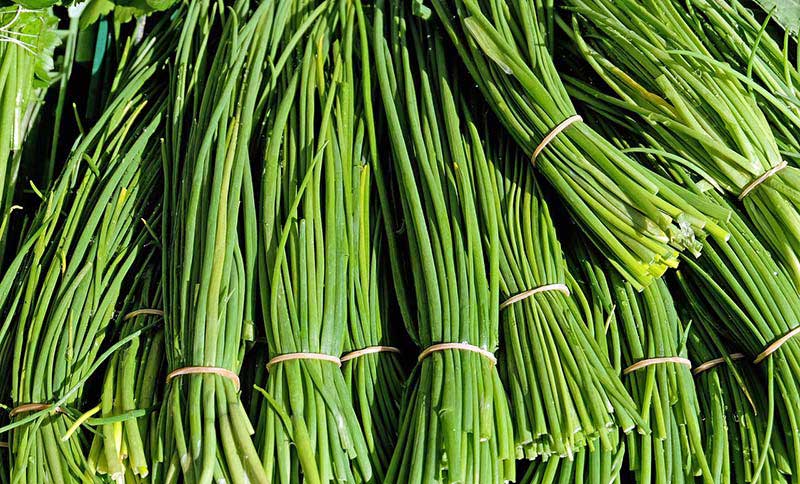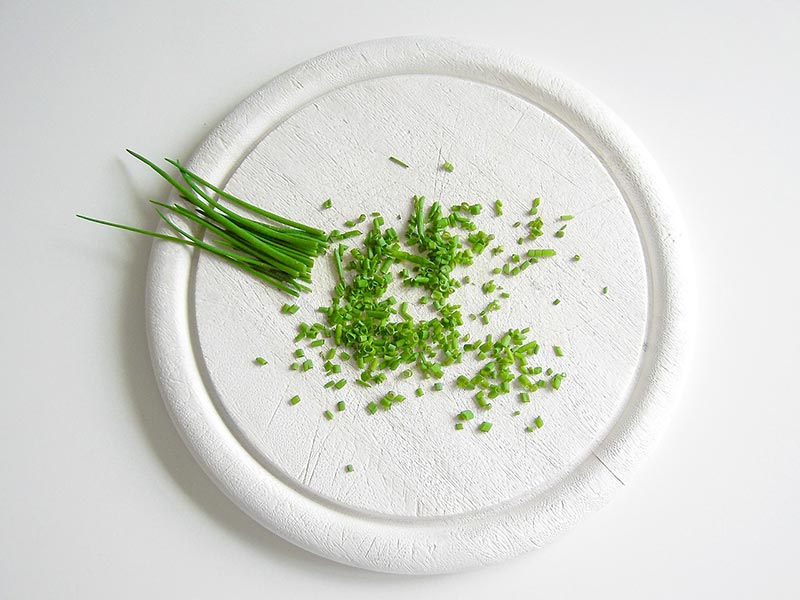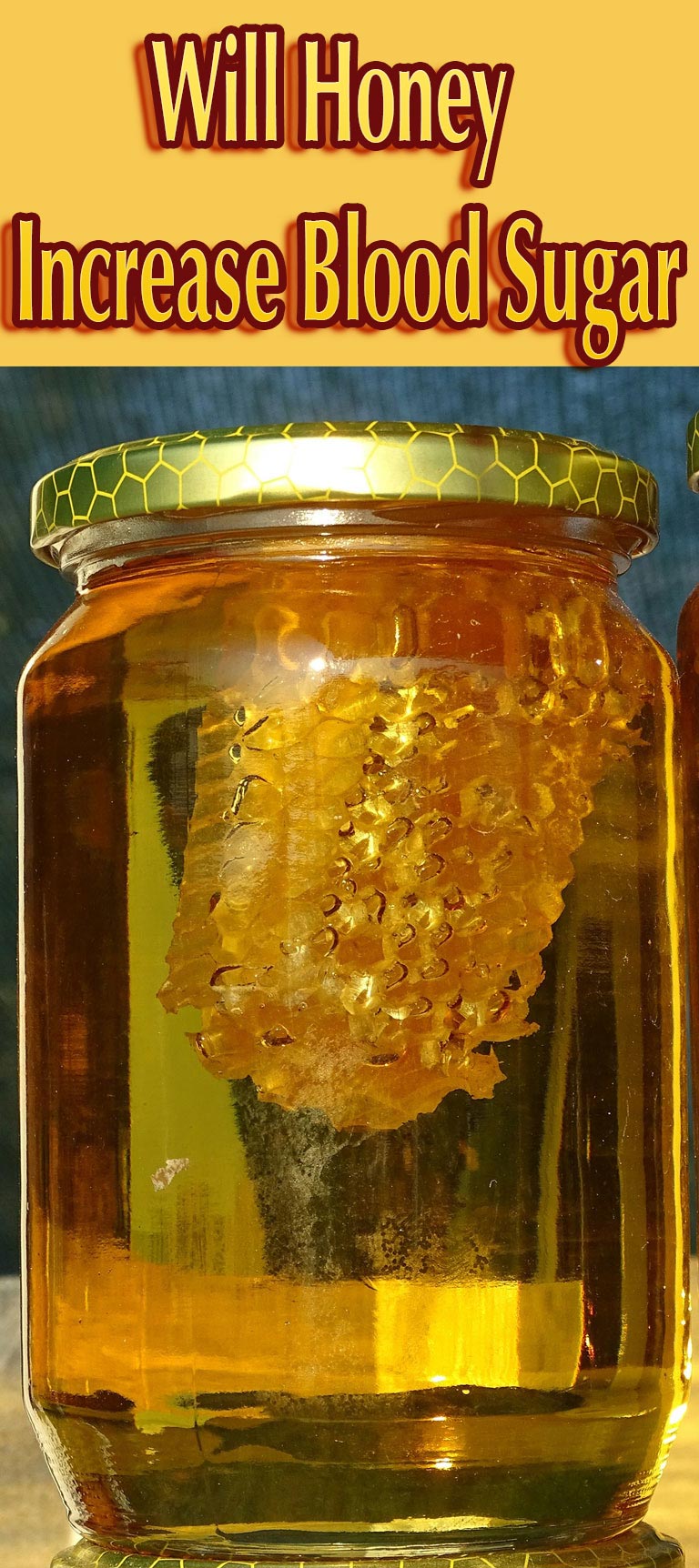
Ask about a fragrant, ever-green herb that adds a hint of pleasantly subtle, onion-garlic flavor to savory dishes, and your answer will very likely be chives. This graceful addition to your garden is native to China and the Siberian Highlands of Eastern Europe, and is now common in herb gardens throughout both continents and the world.
While some have trouble telling the difference between chives (related to the lily family), scallions, and even green onions, a few characteristics help chives stand apart. A member of the allium family with garlic, shallots, and leeks, chive “stalks” are extremely slender and hollow with the appearance of lush, one-foot-high grass, the largest being less than the circumference of a pencil. Perennials that stand a foot tall on average, chives are hardy and draught tolerant, growing in tight bunches. In mid-summer, they form beautiful lavender blossoms with the appearance of spiky spheres.
Chives are an attractive garnish for green salads, taste great when sprinkled on grilled fish or baked potatoes, and add dimension to creamy potato soup. They’re delicious stirred up in mashed potatoes fines herbes (the classic French combination of chervil, parsley, chives, and tarragon) with a dollop of sour cream. Deviled or scrambled eggs, butters, vinegars, sauces, and nearly any vegetable can be enhanced with a sprinkling of chopped chives. If needing a substitute for this herb, slicing the length of a leek leaf thinly before chopping is a close second. If cooking with chives, it’s best to add them at the last moment to retain their nutritive benefits.
Novice gardeners find chives easy to grow. Chives thrive in full sun and rich, moist soil, although they’ll tolerate partial sun and other soil types and still produce generously. Depending on your culinary needs, harvest by snipping a small handful an inch above the ground when they’re around six inches tall. Chives grow so rapidly that before long the area you cut first will be ready for harvest again. Each spring’s crop is generally double the last, so thinning keeps the chive section of your herb garden tidy.
To even out a section of your chives, a sharp chop with a shovel several inches into the dirt can remove root clumps and all. Give a clump to a friend! This is a great way to share this lovely, versatile garden herb.
Chives Health Benefits
As far as daily recommended values, a generous serving of two tablespoons of chopped chives gives you 16 percent of what’s needed in vitamin K, Known primarily for forming and strengthening bones and limiting neuronal damage in the brain, vitamin K is used in the treatment of Alzheimer’s. Chives are an excellent source of vitamin A –145 percent of the daily recommended value per 100 grams – more than any other allium, and with it, carotenes, which are flavonoid antioxidants like zeaxanthin and lutein that protect you from lung and mouth cancers.
Chives are high in fiber, which acts as a laxative, and folate, which is essential for DNA synthesis, cell division, and helping to prevent neural tube defects in the newborns. They’re an excellent source of calcium, iron, magnesium, potassium, copper, and manganese and also provide healthy amounts of thiamin, niacin, pyridoxine, pantothenic acid, phosphorus, riboflavin, and zinc. This combination of phytochemicals, among other things, is known to promote ease in digestion, soothe upset stomachs, prevent bad breath, and have a diuretic effect that can lower high blood pressure.
The fiber content helps clean the colon and shorten the time foods spend there (and therefore lowers your colon cancer risk. Other advantages of eating chives include having anti-inflammatory, antibiotic, antibacterial, antiviral, antifungal, and antimicrobial properties.
Like other allium members, chives contain antioxidants that kill free radicals. Thiosulfinites like allyl propyl disulfide and diallyl disulfide (known to inhibit breast cancer cells) contain enzymes that convert to allicin when its leaves are cut or crushed. Studies show allicin can cut cholesterol production by inhibiting HMG-CoA reductase, an enzyme responsible for producing cholesterol in liver cells, decreasing blood pressure, blocking platelet clot formation, and lowering the risk of heart disease and stroke.
Studies on Chives
One study noted that natural plant ingredients can be useful antimicrobial agents against foodborne pathogens. The effect of chives on the survival and growth of salmonella in different food systems were examined, using chicken soup, beef broth, and sesame salad dressing divided into two portions. One was treated with chive extract, the second used as a control; both portions were inoculated with a mixture of 38 strains of salmonella.
The tests were conducted three times and the salmonella population found to be below the detectable level in the chicken soup and beef broth. Scientists concluded that chives could inhibit salmonella in different food systems.
In another study, scientists researched the relation between the consumption of allium vegetables such as Chinese chives, garlic, Welsh onion, and raw vegetables, and risks of esophageal and stomach cancer. Results of the study showed that allium vegetables do indeed have an important inhibiting effect on these two types of cancer.








Leave a Reply